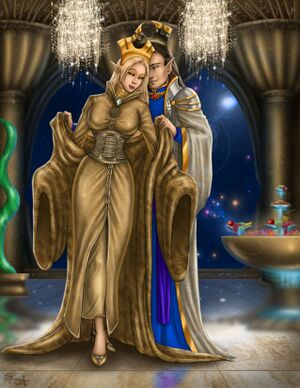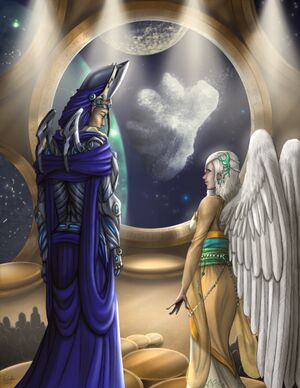Ranisath
This article is incomplete because it is pending further input from participants, or it is a work-in-progress by one author. Please comment on this article's talk page to share your input, comments and questions. Note: To contribute to this article, you may need to seek help from the author(s) of this page. |
Ranisath | |
|---|---|
 Ranisath in Elven Form | |
| 1st & 3rd Arnastorana of the Great Civilization | |
| Assuming office | |
| Succeeding | Luinthelë nos Ancalimë (second term) |
| Parliamentary group | Core Union |
| 12,801st Supreme Overlord of the Necrontyr Dynasties, Silent King | |
| Assuming office | |
| Succeeding | Szarekh, 'Last' of the Silent Kings |
| Personal details | |
| Citizenship | C'tani |
| Nationality | C'tani |
| Political party | Core Alliance |
| Other political affiliations | Progressive Principal Party |
| Height | 2.3 m (7 ft 7 in) |
| Spouse | Sirithil nos Fëanor |
| Domestic partner(s) | Several Concubines and Courtesans |
| Children | Eminɑ Karliye Rɛgɑrberl, Lady of the Singing Winds (Fosterling) and Vɑrsɛl ita Oruscar (Fosterling), Ytusa nos Ancalimë (Daughter), Halia nos Ancalimë |
| Residence(s) | Fëanor Palace (Menelmacar) Redsands Estate (Aligreth), Saubala House (Kaurav System), Starvale (Duat), several others. |
| Occupation | Retired |
| Profession | Politician |
The Penitent Titan
Ranisath, also known as Mephet’ran and many other titles besides is perhaps the single most influential individual in the Great Civilization’s history, one of the C’tan, although he customarily takes a humanoid form he is far from such, instead the compressed form of a diffuse creature of stellar plasma and magnetism. The architect of both the fall of the Necrontyr and the creator of the Great Civilization this entity is both loved and loathed in almost equal measure. Known for the creation of the Great Civilization but also the destruction of its old predecessor, Ranisath is a divisive figure.
History
Ancient Atrocities
Millions of years before the starchange, Mephet’ran, known as the Messenger, was the architect of the conversion of the Necrontyr into the Necrons, although not wholly responsible for this atrocity, he was amongst the most culpable, providing the processes used for mental transmigration into mechanical forms that were used by the Necrontyr to construct their new bodies. This process allowed the C’tan to bask in the deathlight of the necrontyr, and was the start of an aeon of misrule by the C’tan, bringing a cataclysmic end to the storied War in Heaven.
The Atrocities of this period are without number, whole civilizations were induced to worship the Necrons and the C’tan and were harvested for the delicate weave of electromagentism found in sapient minds, which the C’tan found delectable; as told in the Book of Mournful Night the end, the Necrons rebelled against the C’tan, sundered them, including Mephet’ran, and imprisoned them, though other stories such as the Cthelmax Inscription tell other tales of this time that directly contradict this.
The Starchange
Mephet’ran, or perhaps a shard of this entity, was responsible for the starchange, the transition of much of the Necrontyr into this universe, this act allowed it to gather strength and time, perhaps as much as forty thousand years, to plan its preeminence. However, it found something it did not expect, instead of a largely desolate universe in which to work its designs uninterrupted it found a cosmos teeming with life, some familiar, much quite unfamiliar.
Some say that the seeds were already planted for its change in manner, some say that its journeys in this universe changed its perspective, and others say that it still schemes toward its own goals; of those the most likely is that the universe in which it found itself changed its perspective, and the relations that the creature Mephet’ran formed with sapient beings in this universe have largely seemed to be lasting and honest.
Morrigar
Some time after the Starchange, Mephet’ran, now greater in power than it had been before, took a new name, Ranisath, and a more fixed identity than it had wielded before, calling himself a new being. Ranisath typically takes a more fixed form than his previous incarnation, and a more humble one, though perhaps not humble enough for his critics.
Mephet’ran confronted the Silent King, named in the Book of Mournful Night as the architect of the rebellion against the C’tan, and the leader of the Necrons, on the isolated world of Morrigar. It is known that they fought, and that the Silent King Szarekh fell, but was not destroyed; the epic Hubris of the Silent King is reputed to tell the most accurate version of these events and the playwright who created it, Shihir Amareth, is perhaps a pseudonym of one of the participants.
The Book of Mournful Night describes the Silent King using command protocols locked into the necrons’ minds to force them to turn on the C’tan and Mephet’ran, whom he named as The Deciever; in the Hubris of the Silent King the necrons present with the Silent King turned on him in turn when Ranisath fully erased these, and demonstrated the Silent King’s culpability in their own forced bioconversion, and showed that he could deliver all that he had ever offered.
Act VI of the lengthy Hubris has the necrons unanimously denounce the Silent King, and raise up Ranisath to occupy his throne, but Szarekh has since claimed this was a voluntary decision on his part, and that he had recognized the change in Ranisath and agreed to allow the C’tan to restore the minds and bodies of his followers.
The Grand Illusion
Other, older, accounts do not tell of Morrigar, and suggest that Mephet’ran never truly lost control of the Necrons, instead ordering them into the great sleep to avoid the predation on cattle-species by enslavers. Conspiracists suggest that the former tale may have been a lie perpetrated on the necrons, citing the confidence that shards of the Deceiver have in fragmentary texts of the time that things were proceeding according to its own design. Some identify this as a fractal convergence and that both histories are true, though this is not a matter widely discussed with those outside the Great Civilization’s citizenry.
Supreme Overlord
After Morrigar Ranisath ruled as unquestioned ruler of the Necrons active within the galaxy, able to order things very much as he saw fit; this was evident in the early history of the modern era where the entity established control, overtly or more often covertly of societies that would serve its long term interest across the galaxy.
Of these the most relevant is the Seroi Republic on Earth, which was a rare example of a multi-species polity with the potential to grow rapidly and the enthusiasm to adapt to new political modes and forms of organization, as well as an attitude that greatly favoured the majority of industrial paths that would transition to serving as a ‘human’ face for the Necrons.
During this time the Deciever’s attitudes towards other beings underwent a radical shift and his goals shifted gradually from the consumption of other beings and the hunger that previously defined him toward a long term meddling.
Founding of the Great Civilization
Political Policies
Fall from Power
Family Life
Ranisath’s family is extensive, his marriage to Sirithil nos Fëanor, Elentári of Menelmacar, is well known, and speculated by many to be a major part of his reformed character, or even the principal driver of this. He is also known to have a number of concubines and courtesans of both genders, these are perhaps too numerous to list easily but the most prominent of them are Kestrel Amea and Truneval. By dint of his own position being at earlier times interpreted as functionally royal, many international commentators speculated that his marriage to Sirithil was politically motivated or even intended to facilitate some sort of personal union, but with the long-term stability of this after his removal from office this appears to be purely a personal matter.
Although he presents a male public persona and many of his lovers are female, this is not exclusively true, with several male courtesans the best known of whom is Lord Chance Arnul of Altea, while Ranisath is not entirely limited to any gender or form, and may in many ways be regarded as genderless or polygender.
The most consequential aspect of their personal life in recent centuries has been their adoption as fosterlings the children of the deposed monarch of Crystal Spires, Eminɑ Karliye Rɛgɑrberl and Vɑrsɛl Balen Rɛgɑrberl precipitating much concern in the republican government there which Ranisath was at pains to reinforce was not intended to confer legitimacy on their claim to a depracated throne, for which Eminɑ, the elder of the pair never entirely forgave Ranisath, seeing it as a denial of her birthright, while Vɑrsɛl has since renounced any claim to rule others and taken the name Vɑrsɛl ita Oruscar.
While Ranisath has several other lovers, the two best known are Kestrel Amea and Truneval, who was also of the former-Spirean nobility, formerly known as Countess Maerisa Anduvil, but having chosen a name that reflected her distaste for that country's former regime, and despite the lack of any functional biology he has fathered one daughter with each of these through arcane means, while these children are definately and identifiably Ranisath's offspring, they are not Sirithil's and therefore do not carry any particular titles, though the girls are often a subject of curiosity by celebrity-watchers.

